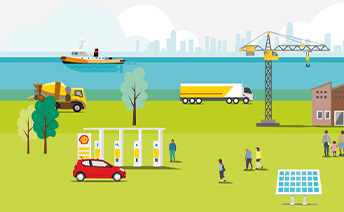Targets used by Shell to manage climate-related risks and opportunities and performance against targets
Shell's material climate-related risks and opportunities are set out in the "Climate-related risks and opportunities identified by Shell over the short, medium and long term" section. Our response to the energy transition risk focuses on decarbonising our value chain. Our climate targets are focused on reducing our NCI and our absolute emissions, as presented in the Scope 1, Scope 2 and Scope 3 emissions and related risks and Scope 3 and net carbon intensity sections.
Setting targets for NCI
Shell's target is to become a net-zero emissions energy business by 2050. We also have short-, medium- and long-term targets to reduce the carbon intensity of the energy products we sell, measured using our NCI metric. We believe these targets are aligned with the more ambitious goal of the Paris Agreement, which is to limit the rise in global average temperature this century to 1.5°C above pre-industrial levels.
There is no established standard for aligning an energy supplier's decarbonisation targets within the 1.5°C temperature goal of the Paris Agreement. For this reason, we have defined our NCI target using 1.5°C scenarios developed for the IPCC's AR6.
We start with the complete set of 1.5°C scenarios and then exclude scenarios which are too reliant on carbon removals or use of bioenergy before removing outliers. We then calculate an emissions intensity for each scenario which is comparable to our own NCI. Finally, we produce a 1.5°C pathway based on the reductions in emissions intensity over time. We have chosen to use a range instead of any individual scenario to better reflect the uncertainty of the energy transition.
We believe that using this pathway to set our targets demonstrates that they are aligned with the more ambitious 1.5°C goal of the Paris Agreement. This is illustrated in the chart below.
We also believe that the pace of change will vary around the world by region and by sector, taking into consideration the time needed for energy users to invest in large-scale equipment and the energy infrastructure changes needed for Shell to deliver more low- and zero-carbon energy.
Shell's Paris-aligned targets
Scope 1 and 2 progress towards target
The chart below shows our progress since 2016 in reducing our Scope 1 and 2 emissions and gives an indication of how we expect to achieve our target in 2030. The actions we will take to achieve our target will depend on the evolution of our asset portfolio and the continued development of technologies which reduce carbon emissions. We expect that on a net portfolio basis, new investments across our portfolio will increase our Scope 1 and 2 emissions between 2024 and 2030, but this increase will be outweighed by reductions associated with planned divestments and natural decline. Our investments in producing low-carbon energy such as biofuels will increase our Scope 1 and 2 emissions, while reducing the NCI of the products we sell. Subsequent reductions in our emissions are reflected in the mechanisms outlined below and reflect an expected path to meeting our target in 2030. To decarbonise our operations, we are focusing on:
- making portfolio changes such as acquisitions and investments in new, low-carbon projects. We are also decommissioning plants, divesting assets, and reducing our production through the natural decline of existing oil and gas fields;
- improving the energy efficiency of our operations;
- transforming our remaining integrated refineries into low-carbon energy and chemicals parks, which involves decommissioning plants;
- using more renewable electricity to power our operations; and
- developing carbon capture and storage (CCS) for our facilities.
If required, we may choose to use high-quality carbon credits to offset any remaining emissions from our operations, in line with the mitigation hierarchy of avoid, reduce, and compensate.
Working to reduce our absolute Scope 1 and 2 emissions
Scope 1 and 2 emissions in million tonnes of CO2e [A],[B]
[B] Operational control boundary.
[C] Including nature-based solutions.
NCI progress towards target
The biggest driver for reducing our NCI is increasing the sales of and demand for low-carbon energy. The chart below illustrates how changes in the volume of products and services we sell could result in NCI reductions to 2030. The change in our sales of these products and services will also reflect the development and adoption of new technologies and infrastructure, and the adoption of public policies designed to encourage the energy transition.
Working to reduce our NCI
NCI in gCO2e/MJ [A]
[B] Hydrocarbon sales reflect the effect of lower sales of oil products, and higher sales of natural gas. Emissions associated with gas are lower than those of oil products.
[C] Power sales show the expected growth of our integrated power business and increasing sales of renewable power.
[D] Sales of low-carbon fuels reflect higher sales of biofuels and hydrogen, which are low- and zero-carbon products.
[E] CCS reduces carbon emissions by capturing them at source.
[F] Carbon credits such as nature-based solutions can be used to offset remaining carbon emissions, particularly in hard-to-abate sectors such as aviation and industries including cement and steel.
Linking Shell's emissions targets to remuneration
We have established remuneration structures to support us in reducing our operational emissions and to support customers in reducing their emissions. Our annual bonus scorecard, Long-term Incentive Plan (LTIP) and Performance Share Plan (PSP) contain "Shell's journey in the energy transition" performance metrics designed to ensure that remuneration is clearly aligned with Shell's operating plan and longer-term strategic ambitions.
Almost all employees participate in the annual bonus scheme which is linked to the Group scorecard. Executive Directors and around 130 senior executives participate in the LTIP and around 17,800 employees participate in the PSP, which is designed to retain key employees and ensure they have a greater investment in Shell's future.
The LTIP and the PSP measure performance over a three-year performance period. Executive Directors' awards are also subject to a further three-year holding period after vesting. Executive Directors and senior executives are also subject to ongoing shareholding requirements.
Energy transition performance condition and the vesting of the 2021 LTIP and PSP awards
The following performance outcomes for the energy transition performance condition were considered in the assessment of the 2021 LTIP and PSP vest, covering the performance cycle 2021-2023:
|
Outcome |
|---|---|
Net carbon intensity (NCI) |
Performance indicator met |
Growing the power business |
Substantively met |
Growing new lower-carbon product offerings |
Partially met |
Develop emissions sinks |
Not met |
In addition to the above, a number of broader indicators of Shell's progress in the energy transition were considered. Overall, it was determined that the energy transition measure (accounting for 20% of the LTIP award and 10% of the PSP award) should vest at 120%.
Energy transition performance condition in the 2023 LTIP and PSP awards
For LTIP and PSP awards granted in 2023, the energy transition performance condition had a weighting of 12.5% for the PSP and 25% for the LTIP. The performance condition for these awards is based on NCI reduction and the supporting strategic themes of reducing Scope 1 and 2 emissions; building a renewable power business; growing new low-carbon energy offerings; and developing emission sinks and offsets. The vesting outcome is at the discretion of the REMCO who will make a holistic assessment of progress when making the vesting decisions.
Energy transition performance condition for 2024 LTIP awards
For the 2024 LTIP and PSP awards, the "Shell's journey in the energy transition" performance condition retains the same weightings as for 2023. The REMCO's determination of the extent to which awards will vest will be based on its holistic assessment of progress towards reducing emissions from our operations and supporting our customers to reduce their emissions. This will be based on our journey to net-zero climate targets for our own operations of:
- Halving Scope 1 and 2 emissions by 2030 under operational control on a net basis (2016 baseline);
- Eliminating routine flaring from upstream operations by 2025 [A]; and
- Maintaining methane emissions intensity below 0.2% and achieving near-zero methane emissions by 2030.
The REMCO will also take into account progress in developments that support the energy transition to 2030 and beyond, such as the development of our Power business (including renewables), lower-carbon LNG, biofuels, electric vehicle charging, hydrogen and carbon capture and storage (CCS).
[A] Subject to completion of the sale of SPDC.
The REMCO will take into account progress towards achieving a 15-20% reduction in NCI by 2030 (2016 baseline) and a 15-20% reduction in customer emissions from the use of our oil products by 2030 (2021 baseline) [A] as well as Shell's wider performance in accelerating the energy transition, e.g. demonstrating leadership and advocacy in standard-setting, alongside any other factors that the REMCO considers material.
[A] Customer emissions from the use of our oil products (Scope 3, Category 11) were 517 million tonnes CO2e in 2023 and 569 million tonnes CO2e in 2021.
See "Annual Report on Remuneration" for more information on the proposed performance framework.
Energy transition targets in the annual bonus scorecard
Delivering on our net-zero emissions target is a part of the annual scorecard, which helps determine annual performance bonus outcomes for senior management and almost all of Shell's employees.
The energy transition progress measures are shown in the table below.
|
|
2023 Target |
2023 Performance |
2023 Status |
||
|---|---|---|---|---|---|---|
Reducing operational emissions |
thousand tonnes of CO2 |
800 |
1,081 |
Outstanding |
||
Selling lower-carbon products |
% [A] |
60 |
54 |
Below the target |
||
Electric vehicle charge points |
Number |
180,000 |
195,500 |
Above the target |
||
|
||||||
The 2023 full-year outcome for selling lower-carbon products was below target (but above threshold level) for a range of reasons including lower lubricants demand and higher costs for lower-carbon Mobility products.
In 2023, the outcome for operational emissions reductions was outstanding, reflecting the cumulative effects of actions across the portfolio, which support our target to halve Scope 1 and 2 operational emissions by 2030 (when compared to the 2016 baseline). This includes abatement projects, use of renewable energy, and permanent shutdowns or conversions ("right-sizing") of assets.
We are building an electric vehicle charging business to help decarbonise road transport. In 2023 we opened 60 new electric vehicle charging hubs in Belgium, China, Germany and the Netherlands, including our biggest electric vehicle charging site in the world in China, together with our joint-venture partner BYD.
In 2024, the REMCO has adjusted the energy transition measure in our annual scorecard in light of the energy transition strategy update, continuing to align to Shell's strategic objective of becoming a net-zero emissions energy business by 2050, supporting a balanced energy transition by responsibly delivering the oil and gas people need today, while helping to build the clean energy system of the future. The metric "Shell's journey in the energy transition" in the annual bonus scorecard represents:
- LNG volumes – equity liquefaction;
- Reducing operational emissions – operational actions to reduce emissions in support of our target to achieve a 50% reduction in Scope 1 and 2 emission by 2030, on a net basis; and
- Support customer decarbonisation – electric vehicle charge point roll-out.
Metrics and targets in respect of climate-related environmental risks
We have set a target to reduce the amount of fresh water consumed in our facilities, starting by reducing our consumption of fresh water by 15% by 2025, compared with 2018 levels, in areas where there is high pressure on fresh-water resources. We also monitor the level of waste disposed of from our operations and businesses are now setting local waste management targets and developing implementation plans based on waste and circularity assessments that we have conducted. In 2023, we continued to implement our biodiversity commitments in our projects and assets, with critical and forest habitats as priorities.
See "Respecting nature" and "How we create value" for more information.
Basis of preparation – net carbon intensity (NCI)
Shell's NCI is the average intensity, weighted by sales volumes, of the energy products sold by Shell. It is tracked, measured and reported using the Net Carbon Footprint (NCF) methodology.
We have received third-party limited assurance on our NCI for the period 2016 to 2023.
Scope of NCI
Shell's NCI provides an annual measure of the life-cycle emissions intensity of the portfolio of energy products sold. The intended use of the NCI metric is to track progress in reducing the overall carbon intensity of the energy products sold by Shell. The NCI is calculated on a life-cycle basis and as such includes GHG emissions – on an equity basis – from several sources, including:
- direct GHG emissions from Shell operations;
- indirect GHG emissions from generation of energy consumed by Shell; and
- indirect GHG emissions from the use of the products we sell.
Emissions from other parts of the product life cycle are also included, such as those from the extraction, transport and processing of crude oil, gas or other feedstocks and the distribution of products to our customers. Also included are emissions from parts of this life cycle not owned by Shell, such as the extraction of oil and gas processed by Shell but not produced by Shell; or from the production of oil products and electricity marketed by Shell that have not been processed or generated at a Shell facility.
We also take into account emissions mitigated through various measures, such as by creating carbon sinks by working with nature – including through protecting forests and wetlands – and by using CCS technology.
See "Scope of NCI" for details of the supply chains and steps in the product life cycles that are included in the Net Carbon Footprint methodology.
The following GHG emissions are not included in the NCI:
- emissions from production, processing, use and end-of-life treatment of non-energy products, such as chemicals and lubricants;
- emissions from third-party processing of sold intermediate products, such as the manufacture of plastics from feedstocks sold by Shell;
- emissions associated with the construction and decommissioning of production and manufacturing facilities;
- emissions associated with the production of fuels purchased to generate energy on site at a Shell facility;
- other indirect emissions from waste generated in operations, business travel, employee commuting, transmission and distribution losses associated with imported electricity, franchises and investments; and
- emissions from capital goods, defined by the GHG Protocol as including fixed assets or property, plant and equipment, and other goods and services not related to purchased energy feedstocks sourced from third parties or energy products manufactured by third parties and sold by Shell.
The NCI calculation uses Shell's energy product sales volumes data, as disclosed in this Report. This excludes certain sales volumes such as:
- certain contracts held for trading purposes reported net rather than gross. Business-specific methodologies to net volumes have been applied in oil products and pipeline gas and power. Paper trades that do not result in physical product delivery are excluded; and
- retail sales volumes from markets where Shell operates under trademark licensing agreements.
The energy products included in the NCI calculation are oil products, (gasoline, diesel, kerosene, fuel oil and LPG), GTL, biofuels, liquefied natural gas, pipeline gas and power.
The impact of acquisitions and divestments on emissions and sales volumes is included in actual NCI performance tracking with the target and baseline unchanged. Acquisitions and divestments could have a material impact on meeting the NCI targets.
The NCI is not a mathematical derivation of total emissions divided by total energy, nor is it an inventory of absolute emissions. It is a weighted average of the life-cycle CO2 intensities of different energy products, normalising them to the same point relative to their final end-use. The use of a consistent functional unit, grams of carbon dioxide equivalent per megajoule (gCO2e/MJ), allows like-for-like comparisons and the aggregation of individual life-cycle intensities for a range of energy products including renewables.
See our NCF methodology documentation (shell.com/ghg) for further information.
Basis of preparation – absolute Scope 1, 2 and 3 emissions
We follow the GHG Protocol's Corporate Accounting and Reporting Standard, which defines three scopes of GHG emissions:
- Scope 1: direct GHG emissions from sources under Shell's operational control.
- Scope 2: indirect GHG emissions from generation of purchased energy consumed by Shell assets under operational control.
- Scope 3: other indirect GHG emissions, including emissions associated with the use of energy products sold by Shell.
GHG emissions comprise CO2, methane (CH4), nitrous oxide, hydrofluorocarbons, perfluorocarbons, sulphur hexafluoride and nitrogen trifluoride, with CO2 and methane being the most significant contributors. Our GHG inventory was prepared in line with the requirements outlined in the ISO 14064-1:2018 Specification with Guidance at the Organisational Level for Quantification and Reporting of Greenhouse Gas Emissions and Removals and the GHG Protocol's Corporate Accounting and Reporting Standard.
In line with external standards, Shell aggregates its GHG emissions into tonnes of CO2 equivalent by applying global warming potential (GWP) factors to non-CO2 GHGs. These factors are taken from the IPCC's Fifth Assessment Report (AR5) over a 100-year time period, in line with the UK Government GHG Conversion Factors for Company Reporting. GHG emissions for 2023 were calculated using AR5 GWPs, which were applied prospectively. For comparison our Scope 1 emissions would have been 49 million tonnes in 2023 if we were to have used GWPs from the IPCC's Fourth Assessment Report (AR4).
GHG emissions are aggregated using a bottom-up approach: emission source → asset → operating unit → business → Group. GHG emissions in this Report include emissions from Integrated Gas and Upstream, Renewables and Energy Solutions and Downstream (Chemicals and Products and Marketing) and Projects & Technology, plus Shell's functions. All operated assets are included in the GHG inventory in the reporting period.
Basis of preparation – Scope 1 emissions
Sources included in Scope 1 emissions comprised:
- combustion of carbon-containing fuels in stationary equipment (e.g. boilers, gas turbines) for energy generation;
- combustion of carbon-containing fuels in mobile equipment (e.g. trucks, vessels, mobile rigs);
- flares;
- venting and emissions from industrial processes (e.g. hydrogen plants, catalytic cracking units); and
- fugitive emissions, including piping and equipment leaks and non-routine events.
Our Scope 1 emissions follow the GHG Protocol guidance. As a result, the following were not included in our reported Scope 1 emissions:
- CO2 emissions from biogenic sources (for example, biofuels, biomass), whereas methane and nitrous oxide emissions from biogenic sources were included in our Scope 1 emissions.
- Captured CO2 that was subsequently sold or otherwise transferred to third parties.
- CO2 captured and sequestered using CCS technologies. However, the emissions from operating CCS were included in our Scope 1 and 2 emissions.
- Carbon credits.
All significant sources were included in the Scope 1 inventory.
Basis of preparation – Scope 2 emissions
Sources included in Scope 2 emissions comprised indirect emissions from purchased and consumed electricity, steam and heat. We did not identify any assets with imported cooling or compressed air used for energy purposes.
Scope 2 emissions were calculated using the market- and location-based methods separately as defined by the GHG Protocol Scope 2 Guidance.
All significant sources were included in our Scope 2 inventory.
Basis of preparation – Scope 3 emissions
This Report provides Scope 3 emissions associated with our energy product sales. They were consolidated using the equity boundary approach. Under this approach, we reported the Shell share of emissions from energy products sold, including those sourced from third parties. The calculation of Scope 3 emissions uses energy product sales volumes data, disclosed in this Report where relevant. These sales volumes exclude certain contracts held for trading purposes and reported net rather than gross. Business-specific methodologies have been applied to net volumes of oil products, pipeline gas and power. Paper trades that do not result in physical product delivery are excluded. Retail sales volumes from markets where Shell operates under trademark licensing agreements are not included in the sales volumes reported by Shell and are therefore excluded from the Scope 3 categories described below.
Scope 3 categories included in this Report consist of the following:
Scope 3, Category 1: purchased goods and services
This category includes well-to-tank emissions from purchased third-party unfinished and finished energy products excluding electricity (which was reported separately under Category 3: fuel and energy-related activities (not included in Scope 1 or Scope 2)).
Emissions in this category were estimated using well-to-tank emission factors for crude oil, natural gas, refined oil products (such as gasoline, and diesel), LNG and biofuels. Because the emission factors include transport, we did not estimate emissions from transport of purchased third-party products separately.
Emissions from purchased non-energy products were not included in this Report.
Scope 3, Category 3: fuel and energy-related activities (not included in Scope 1 and 2)
This category includes well-to-wire emissions from purchased third-party electricity sold by Shell, calculated using the market-based method. Emissions were not adjusted for any potential double-counting of sold natural gas that may have been used for generating this electricity.
This category does not include:
- indirect emissions from generation of imported energy (steam, heat or electricity consumed by our assets). These emissions were reported separately as Scope 2 emissions; and
- well-to-tank emissions from purchased electricity, steam and heat consumed by our assets (i.e. Scope 3 emissions from extraction, refining and transport of primary fuels before their use in the generation of electricity or steam).
Scope 3, Category 9: downstream transport and distribution
This category includes estimated emissions from transport and distribution of energy products produced or refined by Shell. It does not include the emissions associated with transporting third-party products, which are included in Scope 3, Category 1. In order to avoid double-counting the emissions from transport, Scope 1 and 2 emissions from transport included in our equity emissions were subtracted from the total in this category.
Scope 3, Category 11: use of sold products
This category includes estimated emissions from the use of sold energy products, such as LNG, GTL, pipeline gas, refined oil products and biofuels. The emissions consist of two sub-categories: products manufactured and sold by Shell and third-party products sold by Shell.
This category does not include non-energy products that may have been combusted during use (for example, lubricants).
Biogenic CO2 emissions from combustion of sold biofuels
Biogenic CO2 emissions from the combustion of sold biofuels were estimated and reported separately outside of scopes. Methane and nitrous oxide were included in Scope 3, Category 11 in line with the ISO 14064-1:2018 and GHG Protocol requirements.
We did not estimate biogenic CO2 emissions in other Scope 3 categories. It is assumed that the presence of biogenic emissions in other categories is negligible at present.
Other Scope 3 categories
As noted above, this Report only covers Scope 3 GHG emissions associated with our energy product sales.
See our website: shell.com/ghg for other Scope 3 GHG emissions.









